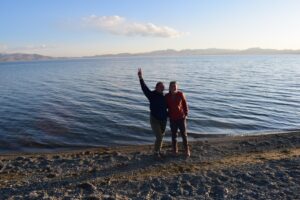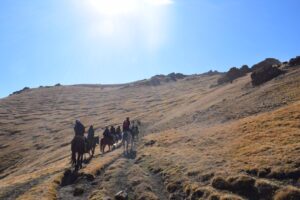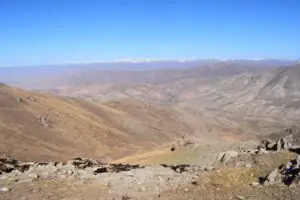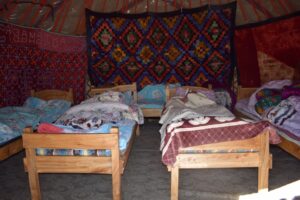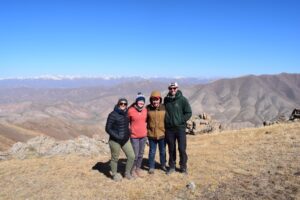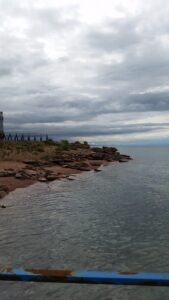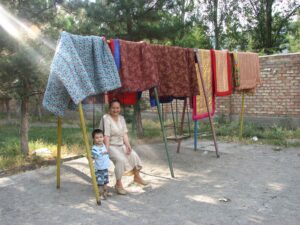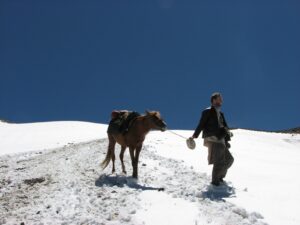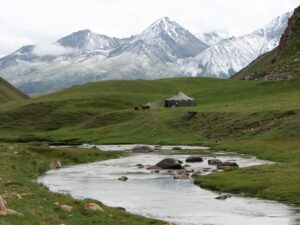While Bishkek is a modern, dynamic and constantly evolving city, it still provides an opportunity to tap into the ancient nomadic traditions of the Kyrgyz people. One of those traditions, horseback traveling, is becoming increasingly popular with SRAS students – and surely for a good reason. Practicing Russian and Kyrgyz while learning about local culture and enjoying authentic Central Asian food already sounds quite tempting, but let’s not forget to add the beauty of the Kyrgyz nature to the mix, to make it truly irresistible.
Below, we’ve compiled some of our students’ observations regarding horse trekking in Kyrgyzstan.
Camryn Vaughn (Fall, 2019)
After the half-day horse trek organized by the London School and SRAS as part of our study abroad experience in Bishkek, a few of us students were left wanting more and decided to plan a second, longer excursion on our own. Four of the eight SRAS students currently in Bishkek agreed to go. There are many companies offering treks and excursions in the mountains of Kyrgyzstan, but typical of broke college kids abroad, we were looking for the best price. Enter: Indy Guide, the Airbnb of tours in Central Asia and Eurasia. All you’ve got to do is search your criteria on their website. For Ross, Sam, Zak, and I, we wanted a weekend trip that left from Bishkek (or nearby) with accommodations, meals, guiding, and transport included for under $200 per person.
Once your criteria are entered, Indy Guide displays excursion organizers that offer treks that match. From that point, you can message the organizer through the website for a full itinerary and to arrange details. We got connected with a guy offering a three-day trek (Friday morning to Sunday afternoon) to the alpine lake Song Kol in the Naryn Region with everything included for $600 total. Split between four people it was $150 each, which was ideal for us.
The full price included:
- transportation from the village Kochkor to where our trek would begin (about 45 minutes outside of the village)
- Lunch and dinner Friday
- Breakfast, lunch, dinner Saturday
- Breakfast and lunch on Sunday
- Accommodation in yurt camps (bedding provided) Friday and Saturday night
- Horses and tack
- An English-speaking guide to accompany us
- Transportation back to Kochkor from where our trek would end (about an hour and a half back to the village)
That left us on our own for finding transportation between Bishkek and Kochkor (a three-hour drive), and a place to stay Thursday night in Kochkor so we could be ready to meet our guide there at 8:00 Friday morning. Ross took the initiative to message our guide and confirm payment and the schedule. He also emailed our London School SRAS program coordinator to adjust our lesson and test on Friday to allow us to depart Thursday night. Our test was moved to next Friday and we missed out on one communication lesson that we couldn’t make up. (Rest assured, our Russian skills were tested on this journey!)
Coincidentally, my host mom invited me to go with her to her hometown the day before when I didn’t have classes. We bought seats in a minivan at the avtovokzal (essentially a bus station for cars) and I found myself in Kochkor! Her brother and his family (who I had previously met in Bishkek) live there and hosted a party. It was suggested that the four of us could stay with the family on Thursday night.
Ross, Sam, Zak, and I came to school that day wearing our hiking shoes and carrying our backpacks. We left class at 4:00 pm and made a pit stop at the nearby shopping center. We needed to stock up on toilet paper and snacks, as well as withdraw dollars to pay our guide. We also got a box of chocolates as a gift for our generous hosts. In hindsight, I should have bought sunscreen as well. Live and learn. We then ordered a taxi to Bishkek’s western avtovokzal because we were not about to try to squish into a marshrutka with our big backpacks.
The avtovokzal is like a bazaar, but for men soliciting rides in their personal vehicles. The ride with my host mom in a regular car the day before cost 250som there and 200som back, so I knew what a good price was so we could avoid being overcharged, as we looked quite foreign. We easily found several minivans departing to our destination and Zak haggled the price down to 350som. The fun thing about these rides is that they don’t leave until all the seats are full. We thought we had it lucky because we pulled out of the station with just the four of us. After about ten minutes of elation, we pulled over to pick up a babushka and two other guys, finding ourselves shoulder to shoulder for the three-hour drive.
We arrived in Kochkor at 8:00 Thursday night and I called my host-uncle and when our driver heard me struggle to relay our location in Russian, he snatched my phone and told my host-uncle himself. A few minutes later we were picked up and treated to a delicious dinner (soup, salad, bread, tea) and good conversation. We slept comfortably in the guest room and had a great breakfast (oatmeal, bread, tea) as well. We felt very grateful for Kyrgyz hospitality – at the time.
Shortly before our guide picked us up at the house, my host-aunt pulled me aside and in Russian that I had trouble understanding, let me know that it was time to pay up – 1000 som each. This is a steep price for Kyrgyzstan! It was unexpected and I was frustrated that she was not being direct and speaking in such a complicated way to dance around the awkwardness of it, so I just gave in and coughed up 4000 som ($57 USD) which we later joked likely inflated the entire village economy. I’m not sure if payment was mentioned at any point by either my host mom or the family before we left and I didn’t catch it, but we felt slightly scammed. Comparatively, we could have easily stayed at a guest house with dinner and breakfast included for around 1000 som ($15 USD) total on booking.com.
The four of us were picked up by the guy who arranged our excursion and he took us to meet our guide on the side of the road. Our guide, Bakyt, studied English at university and guided trips frequently throughout the summer. He told us basic horse-riding instructions: commands for go and stop. That was all it took for us to head into the mountains.
The itinerary promised about five to six hours of horse-riding every day. We stopped for lunch for about an hour and a half after about three or four hours of riding before arriving at our yurt camp for the night. The food was delicious – classic Kyrgyz cuisine such as plov and lagman. At the yurt camps, we met a lot of other travelers, all from different European countries. We had good conversations and made some new friendships throughout our weekend.
We were told to prepare for cold weather in the mountains and we had each brought a backpack stuffed with long pants, sweats, wool socks, sweaters, warm jackets, hats, and mittens. It was really warm during the day and we neglected to bring sunscreen, which was a mistake. I did regret not bringing a pair of shorts to put on once we made it to our overnight yurt camps. It was very cold at night, however, so bringing our warm clothes was absolutely worth it. Both nights, we hiked to the top of a hill to watch the stars. The light pollution was zero, and the Milky Way was incredibly and beautifully clear.
Over the three days, we journeyed across several beautiful mountain passes and jailoos (Kyrgyz for “summer pasture”). Horses, cattle, and sheep were being herded from these summer pastures in the mountains to the village below for winter and we experienced a few traffic jams along the way.
We reached Lake Song Kol Saturday afternoon and camped nearby. In the evening chill, the lake was too cold to swim in, but that didn’t stop me and Sam from trying. The camps we visited on Saturday had flush toilets, a sauna, and stoves in the yurts, which were luxuries we were not expecting. It was a nice relief from the cold night before and trying to do your business in a hole in the dark.
Our way back Sunday, we passed over the Tuz Ashuu pass for a panoramic view of the Song Kol valley. The highest point we were at was 11,154 feet (3400 meters). I woke up that morning with a swollen eye, which my guide informed me can be a symptom of 1) me sleeping on that side of my face or 2) altitude sickness! It was back to normal by the time we reached the bottom of the valley and a van and truck were there to take us and the horses to the village for a final lunch with a host family. After that meal, we were transferred back to Kochkor.
Our guide, who we had then made friends with, also needed to find a ride back to Bishkek so he haggled with mini-van drivers to secure us each a 300 som ride.
We should’ve gotten a discount because at complete fault of our driver, who was trying to pass a line of cars while there were others traveling towards us in the right lane and swerved directly onto a rock, the minivan got a flat tire and we had to pull over and wait on the side of the road for an hour and forty-five minutes.
There is no AAA in Kyrgyzstan. There are, however, other friendly minivan drivers who may be willing to pull over and share their spare tires. The first spare tire we were gifted did not fit, which was discovered after driving down the road for three minutes where we had to pull over again and wave goodbye to our driver who rolled the flat tire to the other side of the road and got into a car without a word. We assumed he went back into the village to repair it, and our theory was confirmed in another hour when he returned with a repaired tire.
At that point, we could continue on at 50mph and we reached Bishkek at 10:30 that night. Although we were all stinky, tired, and in desperate need of showers, we made friends with our fellow mini-bus passengers and got a lot of Russian language practice in. We made sure to give our guide gratuity, the four of us each contributing 1000 som.
Altogether, our trip came to a total cost of 13,119 som each ($188 USD) – still within our initial budget. I would absolutely recommend booking an excursion through Indy Guide. Taking care of transportation between the villages was super helpful, and not having to try to find gear like sleeping bags or tents was ideal. We learned so much from our guide about the region and his experience living in the Kyrgyz countryside. The four of us had a great time bonding over our occasional misfortune, but everyone had a very easy-going attitude and we shared a lot of laughs throughout the weekend. I chose to study Russian in Kyrgyzstan for the country’s nature, and for such a good price, I was very glad I had the opportunity to experience the rugged beauty with such great people.
Mikaela Peters (Summer, 2019)
Horseback riding is a large part of Kyrgyz culture, especially in the more rural areas, and in more recent years has become a tourist activity. With a group of six students led by two guides and with two SRAS staff accompanying us, we got settled on our individual horses and began the hour-and-a-half-long trek up the mountain.
Getting to the place where we would begin horseback riding was in itself a challenge. We drove an hour on the highway before making a turn onto a more local road. After about twenty minutes and two small towns later, we transferred from our marshrutka to a smaller mini-van, which drove about thirty minutes up a grassland littered with huge rocks. A couple of times, we could hear a large rock hit the bottom of the car. It was, without a doubt, the bumpiest car ride I’ve ever experienced.
Earlier that morning, we had signed a waiver, acknowledging that we had watched a video and were now aware of how to behave safely on a horse. Once we were assigned our horses and mounted them the way we were taught in the video and instructed by our accompanying guides, we were taught the commands for how to tell the house to go and stop. Go was “choo,” and stop was a rolled “r,” sound, which is difficult for some Americans to pronounce. The horses seemed to just go with the pack more than they listened to our commands. Some of the horses, such as mine, kept stopping to bend down and graze. I was instructed to not let my horse do this and to yank his reigns back up when he started to bend down.
Despite the fact that the horses were probably used to doing these tourist trips, a couple of the horses did not get along very well with each other. For instance, my horse tended to kick the horse behind it when it got too close. It must have done this about three times. Another horse with personal space issues actually lifted both of its hind legs up off the ground, swinging them around its side, kicking its offender out of the way. After that happened twice, the guides did their best at keeping that horse away from the others.
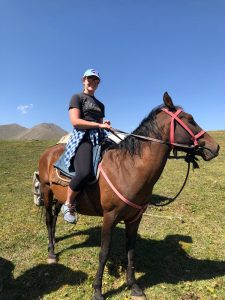
Towards the end of our trek, once we were back down at the bottom of the hill, my horse kept moving its head up and down, which I was told was part of its attempt to get flies out of its eyes. My horse also kept trying to trot, which it shouldn’t do going downhill, because it could hurt its legs. Another safety precaution for the horses was traveling with a dog. This purpose of this dog was to “protect” the horses. One instance of this was when the dog ran over to some nearby grazing cows and barked at them, chasing them away a little. This made way for the horses and eliminated the threat of the cows coming on to the path that the horses were using.
When we had reached the top of the mountain, we dismounted our horses, sticking metal prongs tethered to their saddles into the ground to prevent the horses from running away. From the top of the mountain, you could clearly see three small towns down below. Our one guide said that he lived in one of them and he had been working as a horse guide the past five years.
We also, as part of this excursion, got to help assemble a small yurt – a traditional Kyrgyz nomadic home. In all, the day was an adventure that really showed
Swimming at Issyk Kul
The horse trek was just the beginning of the slew of activities we had ahead of us that weekend. We had a couple of opportunities to go swimming at the lake. At the end of August, the water was refreshing and not overly cold. Where we were staying said no swimming in the lake. Our curiosity got the best of us, and we decided to give swimming a try anyway. Our section of Issyk Kul has rocks for its “beach” and is lined with them at the bottom. After the agonizing pain of walking out to where the water was deeper, yet still being surrounded by jagged rocks, we finally decided to go back, and we finally understood why the sign said no swimming. The next day we entered the lake where there was actually more of a beach that attracted tourists. Entering the lake here was a much less painful experience than it had been the day before.
Similar to the way that American families may go to Florida every summer for vacation, Issyk Kul is a vacation spot of choice for many Kyrgyzstan natives, especially those living in the capital, where it can become absurdly hot in the summer. Because Issyk Kul has been receiving an influx of foreigners, average prices to vacation in the region are rising. This has made it a little more difficult for local Kyrgyz families to continue their annual vacations to Issyk Kul.
Issyk Kul means “warm lake” in Kyrgyz. While surrounded by the snow-capped Tian Shan mountains, the lake never freezes due to its depth, salt content, and the fact that water from local hot springs feed into it. It is the seventh deepest lake in the world. About 118 rivers and streams flow into it. At Lake Issyk Kul, there is a lake, known as the Dead Lake, or Tuk Zol, a salt water lake formed from a decrease in water level from Issyk Kul. It is believed by locals to cure all sorts of skin-related ailments through use of the mud from the lake. The Dead Lake is located 300 meters from Lake Issyk Kul, and is accessible through the village of Kyzyl Tuu.
Issyk Kul in Local Culture
Lake Issyk Kul has long been a centerpiece of local culture and has folktales surrounding it that date back to pre-Islamic times. For example, there is a myth about its formation that says that it started with a local king who had donkey ears. Whenever he would go to get his hair cut, he would have to remove his hat and reveal them to his barber. He threated to killed his barbers if any of them revealed his secret. One barber, unable to contain the explosive secret within himself, yelled the secret into a well, but he didn’t cover the well afterwards. The secret caused the well water to rise and it flooded the kingdom. Today, the ruins of the kingdom lie under the waters of Issyk Kul.
During the time of Soviet Union, the Soviets favored the north shore of the lake, which lead to industrialization of some areas. This created economic prosperity on the north shore, but discouraged traditional Kyrgyz culture there. The south shore remained more rural and traditional. Following the collapse of the Soviet Union, the southern shore became a cultural attraction, having held onto its nomadic cultural heritage.
Today, numerous guesthouses throughout the region serve the tourists who now come to the area for hiking and to view the area’s natural beauty and unique geological formations. Some of these include the Skazka (Fairy Tale) Canyon and the lush, green Barskoon Waterfalls, both of which our group had the opportunity to see.
Arranging a trip to Issyk Kul is worth the effort. Marshrutkas leave for the south shore from Bishkek numerous times a day via Bishkek’s bus station. In addition, travel groups organize these types of excursions, too. Regardless of whether you go to Issyk Kul on a program, with a tour group, or on your own, it is not a natural wonder you want to miss out on.
Daphne Letherer (Fall, 2018)
Just a few hours after stepping off the plane to begin my study abroad experience in Bishkek, I was whisked away on an excursion to Issyk Kul. I found myself on a van full of students I didn’t know, but with whom I quickly became friends. The ride out to the Issyk Kul region was a long four hours over bumpy roads with a driver who swerved around potholes and had no patience for slower travelers.
We arrived Friday evening at a newly built house complete with two full bathrooms and a view of Lake Issyk Kul. We had dinner, prepared by the cooks from the school, in a building in the corner of the yard. My first Kyrgyz meal was composed of delicious noodles and some concoction of meat and vegetables and delicious bread and jam. After dinner, we had a lecture from a teacher about the history of Kyrgyzstan. That night I fell asleep easily and had to drag myself out of bed the next morning to get ready for a day of hiking.
Day 1: Waterfalls and Canyons
Our trusty driver took us down the painfully long dirt road, away from the lake house and to the Barksoon Waterfall. The day was overcast and chilly, but that didn’t stop me from marveling at the beauty of the mountains (or sweating through my sweatshirt). In about a 1-2 hour drive we went from a dry, dusty area covered in rocks to a lush, green mountainside. The hike up to the first waterfall was difficult for me. I was jetlagged and come from a very flat state, so slopes of any kind aren’t exactly my forte. Our guides led us up the mountainside, where trails were basically nonexistent, to the waterfall.
The waterfall was stunning. We spent a long time taking pictures and simply watching the beautiful waterfall and the river flowing into the valley below. Some of the boys crossed the river and climbed closer to the waterfall. After we corralled them back, we went back down the slope and hiked to another beautiful waterfall. As we made our way back to be picked up by the van, we stopped to admire two statues of Yuri Gagarin, placed there because he stayed in Issyk-Kul and visited the falls after his flight to space.
Next, we made our way to the Fairy Тale Canyon (Сказка Каньон). We ate our boxed lunches, half of us squatting on the dirt, the other half perched on wet benches. Besides trading tomatoes, cookies, and pieces of cheese between the lunches, there wasn’t much chatter. But the group didn’t stay quiet for long. As soon as we hiked into the canyon, the group was climbing over everything they could get hold of and begging each other to take their pictures. One member of the group said they overheard a group of older Kyrgyz women laughing at us, saying, endearingly, that we were like monkeys.
We spent a couple of hours exploring the canyon and admiring its stunning view. You could see Lake Issyk-Kul on one side, and green mountains on the other. It was crazy that just a couple of hours before we were somewhere lush and green, and now we were somewhere akin to the Grand Canyon. After scaling mountaintops and sliding down the canyon multiple times, we were driven out to a mysterious complex to do some swimming. The place was very eerie. Long concrete walls displayed faded murals. Concrete yurts sat abandoned along the walls, and the dirt courtyard held old junk. Dogs wandered around and people were dancing near where we entered, but other than that, it was abandoned. Admittedly, I only know the name of the complex because of the schedule that we were given. The water was freezing cold, but people braved it (if only for a few minutes). I didn’t have my swimsuit, or I would’ve dived into the freezing-cold, famous Kyrgyz lake. I had to be satisfied with wading around, finding refuge on large rocks (and occasionally dodging garbage).
Day Two: Horses and Yurts
Unlike Saturday, Sunday was a beautiful day. The sun shone, happy in the sky. I didn’t think any drive could be longer than the muddy one we had taken from the house to the waterfall, but I was wrong. The roads were no longer dirt, but mud, and they felt like rumble strips. It was worth it, though, once we were in the mountains. We stopped in a village in the valley, where we were split up between cars which toted us up the mountain. There, we mounted our horses. Many of us had trouble getting our horses to obey our commands, and we ended up circling around for a long time, trying to master our horsemanship (few did).
None of the horses had names, but I called mine Alejandro. He wasn’t the most amicable horse. Going up the mountain, he was extremely slow. Eventually, one of the guides gave me a whip, and that sped him up, temporarily. The mountainside was beautiful. Initially, I was trying to steer Alejandro away from rocks and dips in the ground, but then I remembered that horses aren’t cars. He knew where he wanted to go. I think our relationship slightly improved after that. We reached the top, where we ate lunch amidst a herd of cows and fog. There was a giant rock on a lip of the mountain, which quickly attracted many of the students. This was the perfect spot to see the valley below, the slopes of the neighboring mountains, and Issyk-Kul nestled in the distance. After climbing all over the rock and taking pictures, we made our way back to the horses.
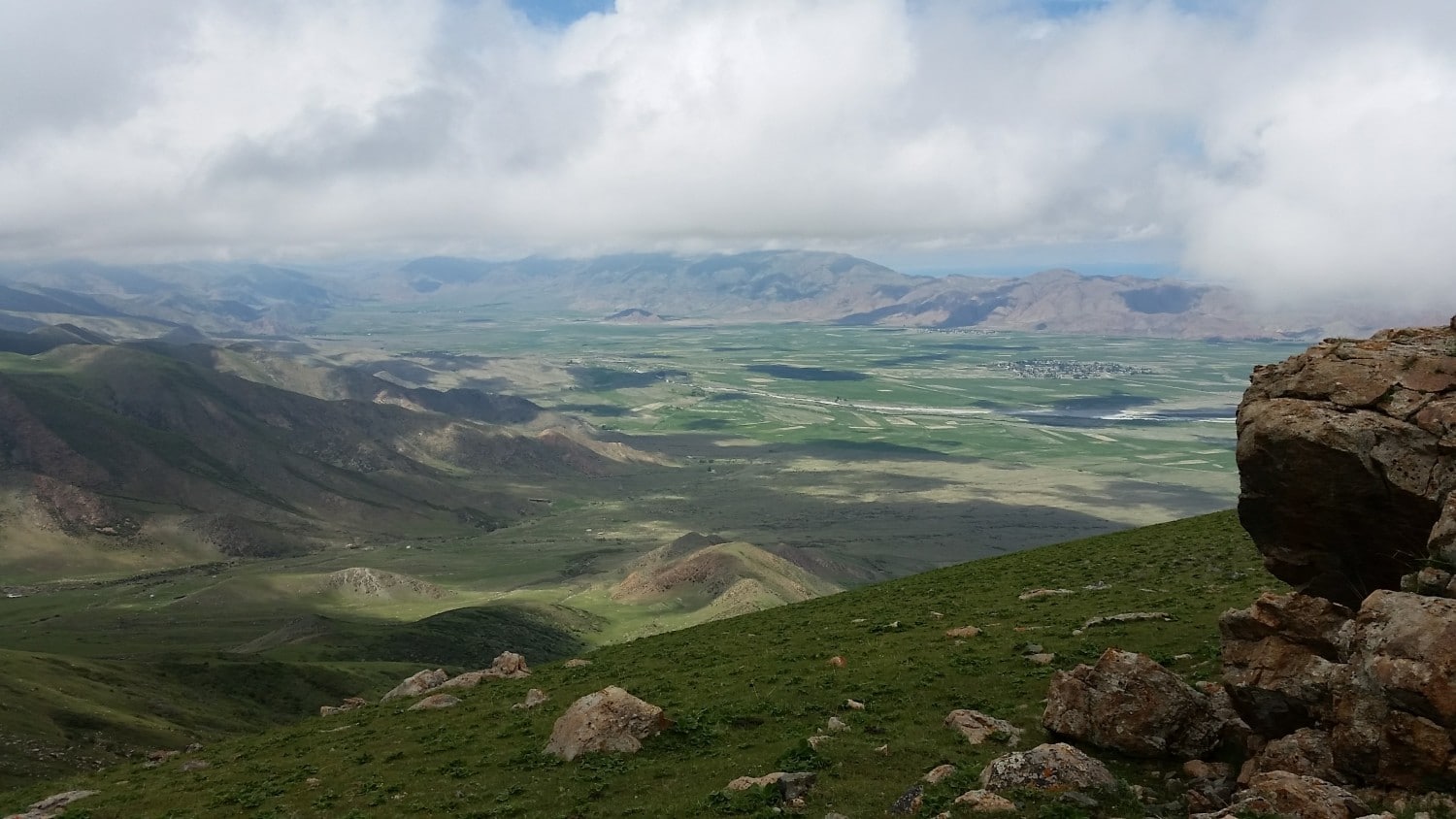
The ride down was certainly more stressful than the ride up. Alejandro slipped at one point, causing my leg to fly out of the stirrup and causing me terror. Then, he decided to get off the path and climb up on the ridge next to it, heading back up the mountain instead of down (to be fair, he wasn’t the only horse who did that). There was a point that I think Alejandro just wanted to get home, because next thing I knew, we were at the front of the pack for the first time. He would begin trotting down, following an ill-behaved horse that kicked the others, switching back before the rest of the group and leaving me very confused on as to where I should be. We returned to the farm, and Alejandro wasted no time in finding his place along the fence.
After dismounting, we were split into two groups. One was invited to the family’s yurt. There, we learned about their decorations and everyday life. The other looked at and pet their foals, which were tied up not far from the yurt. After the groups switched and experienced what the other had, we built a yurt. Well, saying we built a yurt is a little generous. Mostly, we watched the experts (consisting of our guide from the London School, a horse guide, and the young couple to whom the yurt belonged) build a yurt, occasionally stepping in to tie something. First they stood a fence-like frame. Then we all held poles to make the roof and placed yarn decorations on the interior. They placed the swaths of felt on the roof and sides, and ta-da! The yurt was built. I can’t tell you any specifics about the process, because nothing was said about it. All I know is that it was a smaller yurt, for when members of the family travelled. As we stood around the yurt, we were taken over by sheep, which were quickly shooed away. I was amazed by the beauty of the landscape. The horses, sheep, and dwellings of the family who lived there were extremely picturesque with the mountains as their backdrops. Behind green mountains there loomed massive mountains coated in rock and snow, a haze from the distance wrapped around them.
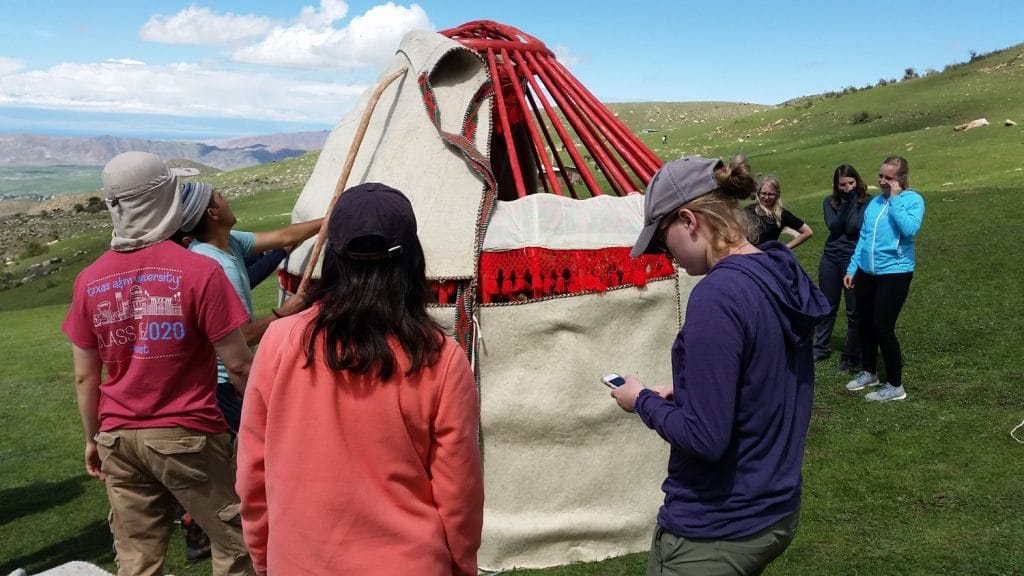
I was certainly spoiled to spend a weekend in the stunning mountains of Kyrgyzstan, by Lake Issyk Kul, during my first days in the country. I’m glad I was able to go on the excursion. Even though I was exhausted, it was beautiful, and it set the tone for my stay here in Kyrgyzstan. I learned about some culture and history, food and environment, before moving into a dorm room and starting to attend class. Now that I’m busy with classes, I certainly appreciate any trips into nature, even if it’s a park in the city. Issyk Kul is a beautiful place that has yet to be developed. If it were a place in the States, surely there would be condos, lake houses, shopping centers, and tourist traps all around. Hiking around Issyk Kul gave me exactly the experience I wanted when I signed up to study Russian in Bishkek and gave me a wonderful introduction to living in Kyrgyzstan.
Margie Marlin (Fall, 2007)
One of my absolute favorite things about travelling is the sensations one experiences when waking up and falling asleep in a foreign country. While not thoroughly confusing, it is disorienting enough to give one a pleasant reminder of the foreignness of one’s new environment. It is a reminder that no matter what happens, one is sure to make a plethora of discoveries before the next day is through. How to describe, then, how much better-than-usual this sensation was in the contrasts of Bishkek, the capital of Kyrgyzstan? After attending my classes for my study abroad experience in Bishkek during the day, I would fall asleep to the sound of a local discotheque, and wake up to the crow of a rooster and the call of a neighbourhood boy that sold fresh kefir and milk each morning.
As Bishkek was an endlessly fascinating mix of the old and the new, so my host family was a mix of different generations. My “Edje” (which is Kyrgyz for elder or “big sister” and is used as a title of respect), was a public schoolteacher who made delicious jam. Nurmuhammed, who went by “Nurick” for short, was my 14-year-old host brother from whom I would learn how to say things like “Duuuude, what’s up? Let’s watch CY55!” CY55, incidentally, is a popular Kazakh game show where they compete to see who can dub American films with the most outlandish substitutions. Rounding out the family was Almaz, grandson of my Edje, a ridiculously adorable and curiously proficient 3-year-old, who spoke Kyrgyz, and some Russian, monkey, and cat and addressed me in all four languages indiscriminately.
At school, my two Russian teachers wasted no time getting me familiar with the alpinisti termini (mountain-climbing terms) I would need for my week-long trek in the Tien Shan mountains which was part of the Kyrgyz Adventure package I had purchased from SRAS. They properly guessed that it was what had chiefly drawn me to study in Kyrgyzstan in the first place. I began to wonder, however, as I carefully recited words like kamenopad (rockslide) and panos (diahrreah), if the horse trek would be more challenging than I had bargained for.
Before I even left for the trek I soon discovered that these instincts were correct. I had asked my boyfriend Dan, who was arrived after I did to join the trek, to bring the camping equipment — but when he arrived we learned that his luggage had been lost. Luckily, I was able to borrow almost everything I needed from the London School of Bishkek, SRAS’s partner in delivering the program. So, I was able to still get a tent, proper shoes, a windjacket, etc. My only remaining privation was to endure wearing two sets of unceasingly wet cotton clothes the whole week while trekking, thus discovering why many mountain climbers nickname this material “death cloth.” Still, it was difficult to complain, given the breathtaking scenery we were experiencing. Staying in the base camp yurt the first night was an experience in itself, complete with the thrill of authentic samovars, oil lamps and children singing Kyrgyz songs at night — this was the charmingly domestic part of mountain life in the Kyrgyz country side, a pleasant overture to the rousing symphony that awaited us.
I should not overstate the surface level of difficulty — we were, after all, horse trekking in Kyrgyzstan. Antony, the third member of our party, had a wonderful time using the horses to orchestrate his mischievous pranks — right from the get-go he amused himself and the rest of us by whipping Dan’s horse in the rear thus sending them hurtling down the mountain at breakneck speed. This, of course, earned him reprimands from the other students and our native Kyrgyz guide, Uzat. Fortunately my horse was stubborn and more interested in eating everything in sight, and so didn’t go crazy with the galloping when prompted. While I loved my horse, it did, at times, stumble and or retreat in fear while crossing some of the stronger rapids and steeper passes. I consoled myself by repeating one of the first equestrian rules: You’ve got to trust your horse!
We also spent a fair amount of time setting up camp and taking shelter, during which most of our energy was spent in futile efforts to dry our things and ourselves. The five of us got to know each other in a most interestingly multilingual way. Besides us three westerners and our guide Uzat, we also had a resident medical intern who traveled with us. His Kyrgyz name we all, for some reason had trouble remembering and so we consistently referred to him simply as “the doctor.” Antony, the doctor, and I could speak Russian; the two locals and Antony spoke Kyrgyz (Antony was learning it for a documentary on bride stealing he was working on); Daniel, Antony and I spoke English between ourselves; and Daniel and Antony chattered in what I like to call “Nerd,” a language which includes dialects such as Wookie and Hut from Star Wars. As we never had a single conversation that everyone could understand, we all had fun translating for each other for both utilitarian and comedic purposes.
Another challenge to overcome was Dan’s previously unknown but increasingly acute allergic reaction to the horses, which resulted in rashes over his arms and legs, constant sneezing and a swollen throat. This condition would be aggravated, we found out, if he even entered the tent containing the horse equipment. None of us had known about this allergy beforehand, so in the absence of commercially produced pharmaceuticals, we followed the doctor’s advice and wiped everything down with vodka at the end of the day, drank vodka (purely for medicinal purposes, of course), and rubbed vodka onto Dan’s skin. The doctor also advised Dan not to drink cold water, something that apparently both the Russians and Kyrgyz believe causes digestive problems. None of us westerners could quite understand this, but at least Antony seemed to have bought into local health culture. Concerned for Dan’s health, he offered him some of his locally purchased dietary supplements: activated coal tablets and Mumio, an herbal supplement made from distilled mouse feces. If these strange offerings weren’t helpful, at least it seems they didn’t do more damage. The challenges were already made easier by our last two nights horse trekking in Kyrgyzstan. Our guides had arranged for us to spend one of these nights at a mountain cottage, and the other spent at the home of a local hunter. The hunter himself was on expedition, but we met his wife and also his hunting partner, an enormous golden eagle with a piercing stare and impressively formidable talons. The hostess’s daughter-in-law, who had been stolen as a bride by the son one year prior, made us some delicious tea and a dish made from cooked horse innards (which Dan, despite the potential allergy problem, very much enjoyed). The highlight of the stay, however, was the hot springs that were located behind this house – a misty cave-like pool that soothed our stiff, damp bones to the core.
The day after this, we made it to our final stop, the famous Lake Issyk Kul — but not before one last, glorious, nerve-wracking trial. The regular path was impassible because of melting snow, and we would have to descend down a glacier instead. The horses stumbled, slid, and stubbornly resisted movement – it was then, on this last day, that I was most truly scared. However, my fear subsided into the wonder of it all before we left the higher regions of the Tien Shan mountains.
As the waters of Issyk Kul, calm and slightly salty, enveloped my sore limbs it was nice to know that the time of danger was over. We would be retrieved by car soon and taken back to the civilization of the capital. The question is, how long until I crave it again? If I can help it, the bulk of the trials horse trekking in Kyrgyzstan still await me — in plentiful quantity, exquisite quality, and accompanied by no end of unforgettable Kyrgyz sunsets.
You Might Also Like
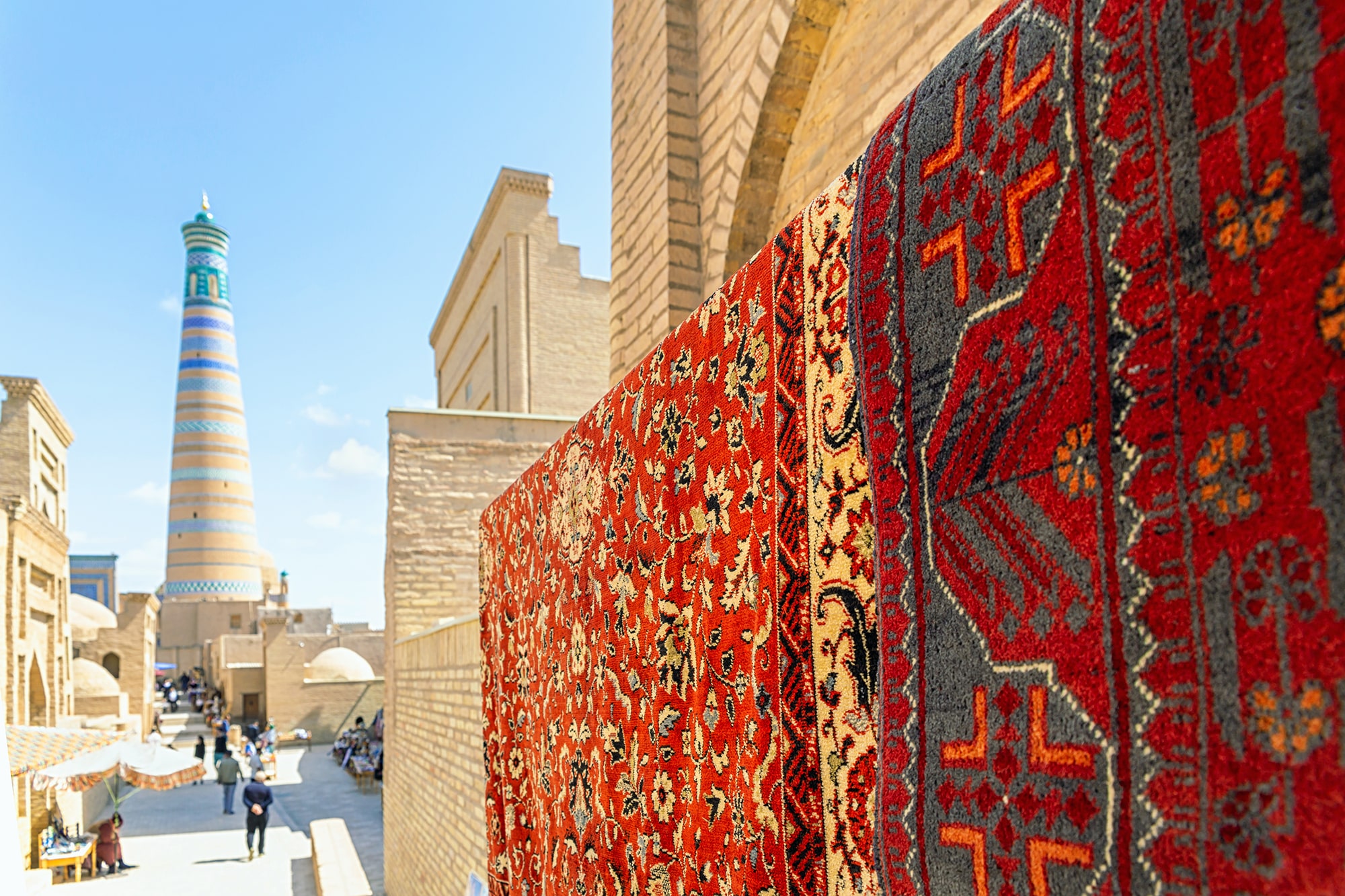
Knots of Culture: Central Asia’s Carpet Weaving Heritage
Central Asia’s rich tradition of carpet weaving reflects the region’s history, culture, and identity. From the ancient nomads of the Pazyryk Valley to the artisans of Kyrgyz yurts and the urban weavers of Samarkand, carpets have long served both practical and symbolic functions. Their materials, techniques, and motifs reflect centuries of interaction between nomadic and […]

The Talking Kyrgyz Phrasebook
The Talking Phrasebook Series presents useful phrases and words in side-by-side translation and with audio files specifically geared to help students work on listening skills and pronunciation. Below, you will find several useful phrases and words. To the left is the English and to the above right is an English transliteration of the Kyrgyz translation. […]
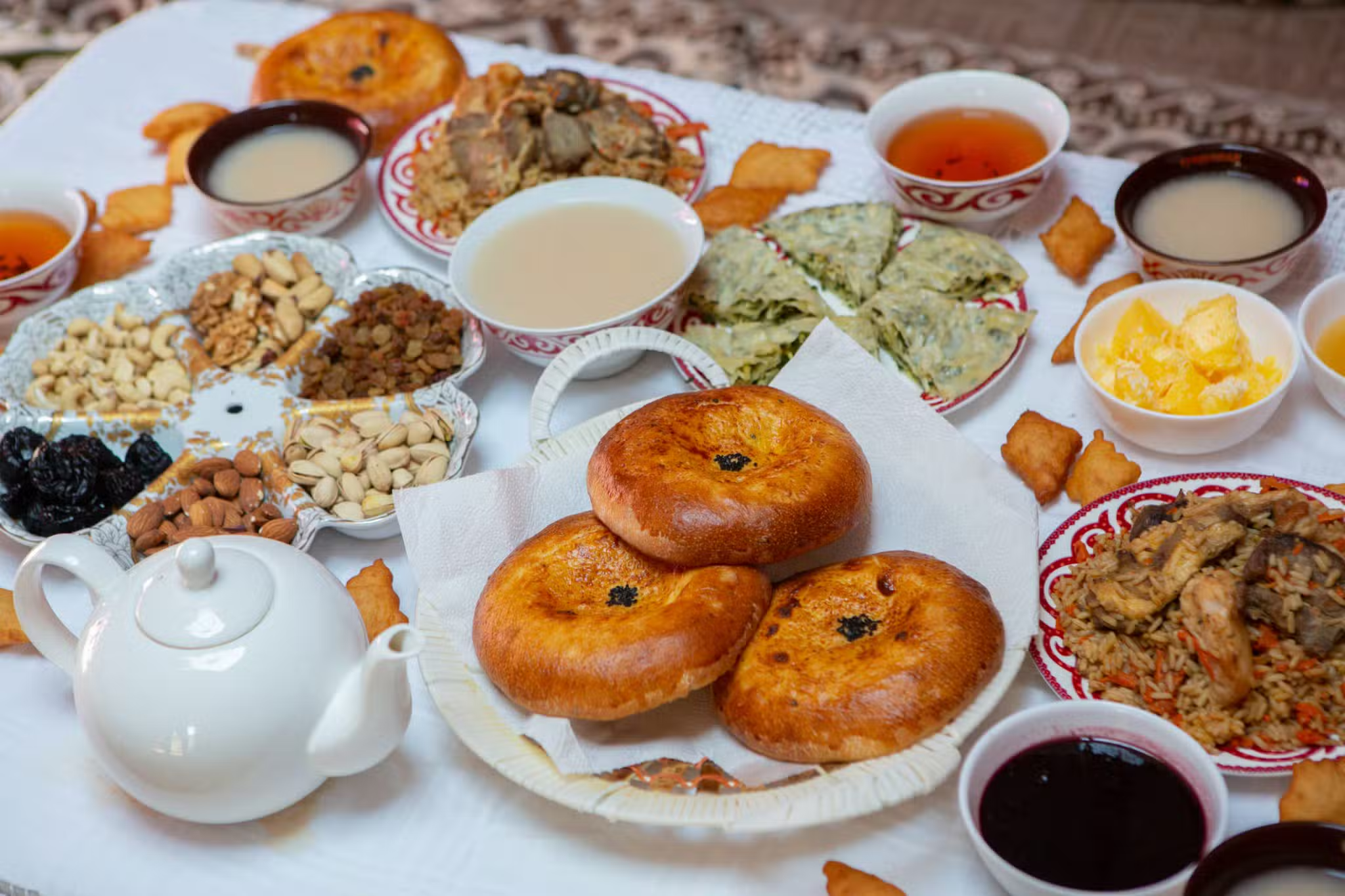
The Kyrgyz Food Dictionary
Kyrgyz cuisine reflects the country’s heritage of pastoral nomadism. Life was spent moving livestock from pasture to pasture and living in collapsible, transportable yurts. The livestock themselves were the primary, sustainable food source. Everything else was either gathered from the land or traded for. The Kyrgyz did not engage in intensive settled agriculture until forced […]
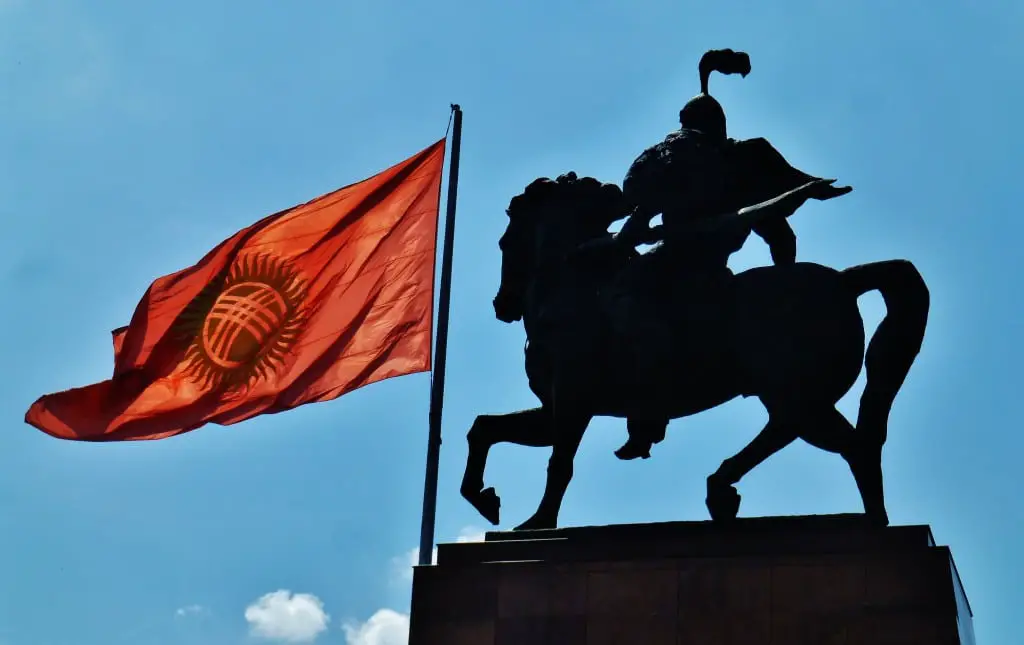
Manas and the Manaschi: Foundations of the Kyrgyz Soul
There are few essential things to know about Kyrgyzstan. One of these is the country’s folkloric hero, Manas. You’ll find nearly everything in Krygyzstan is named after him: the main airport, national parks, major streets in nearly every city and town, and even karate clubs and movie theaters, not to mention the statues of him […]
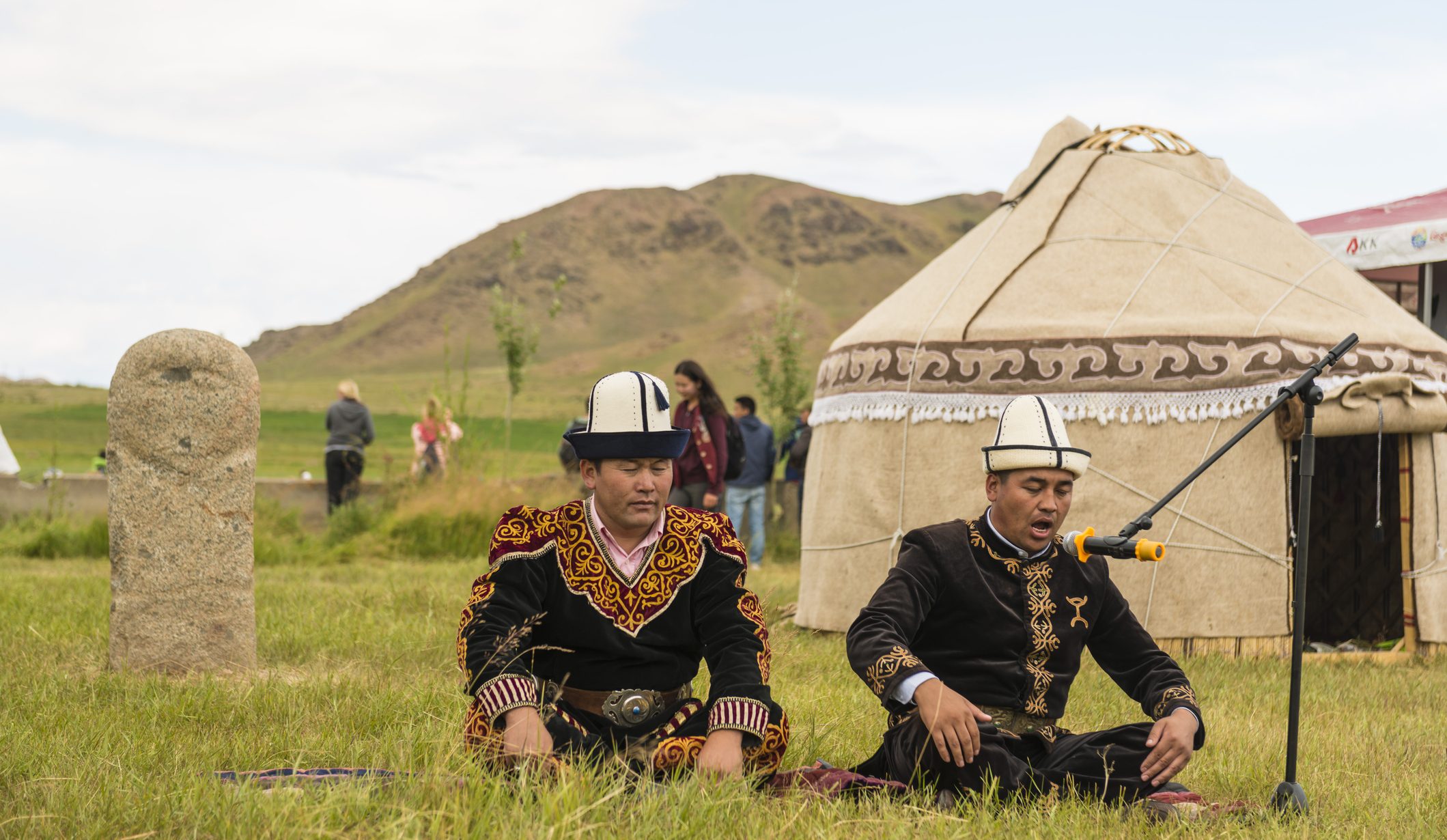
Kyrgyz Identity: Understanding the Kyrgyz National Narrative
What created Kyrgyz national identity? This is a complex question and one that is personal for each Kyrgyz person. This resource will focus on presenting one element of this identity – the Kyrgyz national narrative. Who are the national heroes and what are the pivotal events that they learned about in school? What are the […]


